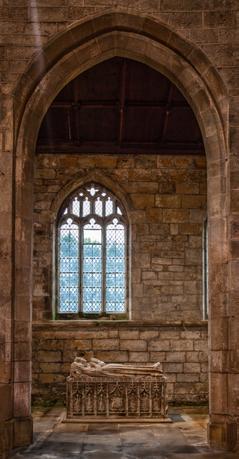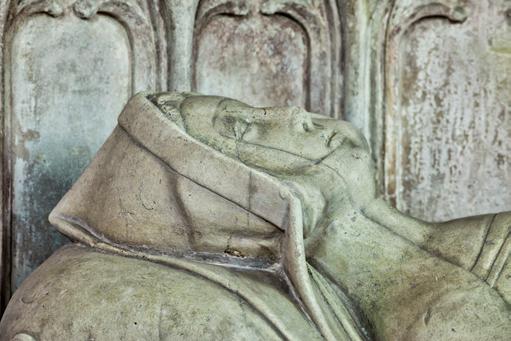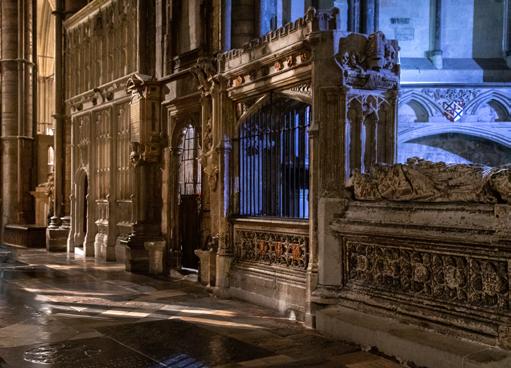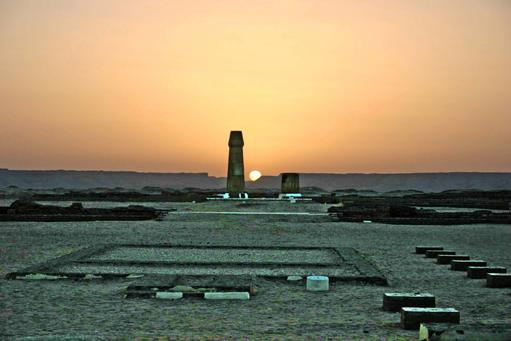
9 minute read
Churches on my
The Hermitage, a holy place hewn from the rock, with simple decorated chambers.
pulled at the doors with the force of a desperate spirit wishing to enter. And then all too soon, my mission complete, and one rather loud bang of the door in the North aisle, it was time for me to leave before I was locked in.
Salisbury Reflections
“Breathe”, I reminded myself as I finished angling the tripod legs between the spouts of perpetually flowing water, and angled my lens so that the rim of the glass kissed the water without making a ripple. And now wait, offering up silent prayer that no one knocked a leg of the tripod and sent my beloved camera into the depths of the font. Guided tours came and went. Visitors ambled at leisure up and down the nave looking but not seeing. People watching whilst you wait is a wonderful past time. Then finally, after a couple of hours, the way was clear, the water was smooth, and the shot was taken.
Norwich
It was a very stormy June afternoon in Norwich, and the cathedral felt like night had descended early. As a result the darker recesses of the cathedral now had a distinct other worldly feel about them, where candlelight and the little natural light available ricocheted off the ancient gnarled stone vaults and columns creating lurking shadows and pools of warm light.
Ely Cathedral, Candlemas
It was a bitterly cold February night sat on a cold stone floor, but it was a beautiful sight to see this majestic space illuminated by candlelight and the sound of the choir filling the capacious nave
The Hermitage
The day had started the night before in an epic drive from Dorset to Northumberland to watch dawn rise over Sycamore Gap (dawn was not that obliging). It did, however, turn out to be a fabulous day. And so this particular June afternoon I found myself taking a pleasant stroll along the waters edge to the point where the boatman could be found. Amongst the long summer grasses was the little landingstage where a little wooden row boat sometimes waits to take people across the little stretch of babbling water.
At first the little path that leads from the landing steps seems wholly unremarkable. Tranquil enough, but simple in its enchantment. And then as you step through the final trees you are suddenly in an open glade inhabited by ancient stones and ancient trees alike.
The most verdant green decorates the rocky walls and uneven steps that lead up into the Hermitage. Except it is not a Hermits retreat but a private chapel associated to or belonging to Warkworth castle. It is a holy place hewn from the rock, with simple decorated chambers. It is a tiny, magical place and once you have explored all that you can it is time to once again be borne back across the river away from this magic, timeless place and back into the sunlight of the 21st century
Harewood, Yorkshire.


Ely Cathedral, Candlemas.


Holkham, Norfolk

Lundy Church
The journey from Bideford to Lundy is a mere 12 miles across the Bristol Channel. The weather was foul and the sea a tumult of crashing power. Waves crossed in all directions as our little vessel lunged and rolled onwards. Our little party had opted to stay on top deck, where, even though we were wrapped in blankets, the wind and rained whipped at us. Down below everyone was ill and the stench was horrifying. Those 12 miles felt like a lifetimes’ journey. But eventually we approached a rock of an island shrouded in mist. It was the start of a week that felt like we had stepped into an Agatha Christie novel. We had rented the mansion house, which now loomed menacingly at us through the gloom and drizzle. I have to say the house was amazing, 1920’s through and through, with no electricity after midnight. Behind our house (we never wanted to leave our little idyll) was a step path that lead to the village (for village read pub) and beyond that inquisitive sheep, Celtic crosses and lighthouses. And eventually you come to St Helens church. St Helens was built in 1896 in the Gothic revival style, but there had been burial grounds here dating back to the 5th century and a church occupied the site from 1244, see Front cover. It’s an unexciting little church architecturally, but wow what a location. This by the by was June and possibly the clearest
Well’s Steps

day we had. But we loved every minute of our photographer’s retreat aided by copious amounts of hot chocolate, gin and a three day game of monopoly set up in the dining room.
Holkham, Norfolk
I had spent my morning in the splendiferous grandeur of marbled halls and gilded finery. And now here I was, seeking the Lady of the house. I had driven to the back of the estate, to find a little church upon a little hill hidden down a gravel path in a wooded glade. The sky had turned a leaden grey and it was drizzling that sort of fine insistent drizzle that clings to your hair and cloths in tiny little droplets. On entering, I was immediately plunged into darkness and having to grapple my way to the inner door.
But what treasures lay the other side of that door. Ancient stones and ancient wood came together to form the body of the church. And then on the left of the nave was a tiny medieval chapel. The worn effigies of long forgotten knights lay low on the stone floor, where the green fauna of neglect was slowly creeping from the corners. I stepped through the narrow doorway, and there in bright white marble was the Countess in question. I gazed upon her for a moment before working the scene and creating the images desired before the light was lost.
Blanche Mortimer, Much Marcle, Herefordshire. She is serene, and so detailed. For all the world she looks to be simply asleep.

It was only as I stepped back to view her again I realised at her feet lay a very new wreath made of wheat and white duck feathers. It would seem someone on the estate still remembered. The Countess’ remains were finally removed and put with the rest of the family, but here remains her effigy, in the church she helped save.
Wells Steps
Sometimes a beloved classic needs a slightly new twist on it. I love the Sea of Stairs at Wells Cathedral, especially where the steps are so very worn by the light step of active feet through centuries gone by. So this particular day, a cool February afternoon, few people were in the cathedral and even fewer in this little corner. So, as is my way, I set myself up on the floor in the entrance to the chapter house. I had a vision of a low angle view incorporating the heavy oak door and the textured wave of the steps.It was a very therapeutic half hour as I sat on the floor of those stairs trying different framing an inch one way or the other. In the end this was my favourite. I like to think it has the feel of someone (maybe the cathedral cat) glimpsing the stairs from the half light of the doorway; neither hidden nor revealed.
Blanche Mortimer
of Blanche Mortimer, daughter of Roger, overthrower of King Edward II, that draws the most attention.
The light was strange the evening I drew up and parked the car. A storm was approaching and there was no sunlight to be found. This was the last stop of my day before heading home, and I had the terrible gnawing in the pit of my stomach that the church would be locked. I can happily report that it was not.
In the darkness of the nave lies a wooden monument, half-forgotten in the gloom. In a side chapel more marvels of the monumental variety await exploration. And then there is Blanche and what is possibly the saddest thing I have ever seen. There she lies in peaceful slumber, her hands placed gently on her stomach, the fabric of her dress falls and gathers in gentle elegance over the side of her recumbent ledge. She is serene, and so detailed. For all the world she looks to simply be asleep - she is indeed a sleeping beauty. And about this gentle lady, is a very modern security system. Someone has already stolen her little dog’s head, and now we know she really does lie in peaceful slumber within her tomb under several layers of lead, the decisions has been taken to protect her with cameras and motion sensors. It is better than locking the church, but still sad that we have reached this stage where the memory of the dead needs this type of protection.
Chantries and chapels of the North Ambulatory Aisle, Westminster.


Chapels on the north, Westminster
Bathed in blue light intermingled with light emanating from the behind the Confessors’ chapel, fingers of light crawl into the darkness and illuminate the tantalising details strewn across the chantries and chapels of the North Ambulatory Aisle looking west to the Islip Chantry at the furthest point then the Chapel of St John the Baptists, its little entry step warn in the middle by centuries of feet. And the tombs of Abbott George Fascet dating to 1500 and the effigy of Thomas Ruthall, Bishop of Durham and Secretary to Henry VII.
Tomb of the unknown soldier
This was the last shot of the evening at Westminster Abbey. However, the evening lighting in the nave is not especially inspiring nor flattering. So, having decided I wanted the vastness of the nave to juxtapose the smallest of the Tomb of The Unknown Soldier, I had very quickly concluded that this was going to be a black and white piece, with a splash of colour. Thus, creating a sombre mood with the shining beacon of hope in the red poppies of the tomb.
AMANDA MILLER LRPS







